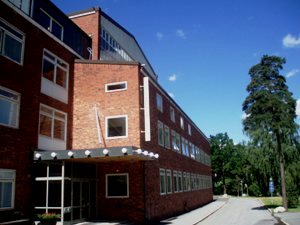KTH Campus
KTH Campus

The house guide can be found in its entirety on our website.
Waste disposal
Returned paper is sorted locally on each floor. Some source sorting takes place in the kitchenette and lunchroom. The building's waste room is located at building 2 on floor 2, where waste is sorted into different fractions.
Akademiska Hus is responsible for handling household waste and KTH for other waste fractions. The user is responsible for removing pallets and packaging.
Evacuation alarm in case of fire
The building has smoke detectors that automatically trigger an evacuation alarm in case of fire smoke. The signal to evacuate is given via a fire alarm and on the RWC also in combination with a red flashing light.
In the event of a fire, call 112 , as the evacuation alarm is not forwarded to the Rescue Service.
Of course, no two fires are the same and it depends on the circumstances how you should act in each individual case. Still, learn the basic rule:
ALARM - WARN - ALARM - EXTINGUISH
The escape routes are marked with green escape signs. Evacuation plans are posted on each floor and show escape routes, deployed hand fire extinguishers, evacuation points in case of fire and assembly point.
The meeting place is in the park at Teknikringen 10.
When the evacuation alarm is triggered, all personnel must close windows and doors behind them, leave the building and gather at the assembly point.
The lifts must not be used in case of fire.
General ventilation
The ventilation in the building is adapted to the number of people and the equipment planned in the rooms.
Cooling supply in the building takes place via chilled supply air and via pipe systems with chilled water to cooling beams in the ceiling.
Presence detection (automatic function)
In the room there is a presence detector which is used to control the temperature in the room. When the presence sensor in the room does not detect presence (= night on the display of the control center) and the room does not need heating, the actuator on the radiator closes down to 18 ° in the room (energy saving function)
When the presence sensor in the room detects presence and the room needs heating, the actuator on the radiator opens to achieve the temperature set on the control center.
Radiators
There are radiators in the building for heat and to prevent frostbite.
Extended operating time and ventilation
After regular office hours, the ventilation is switched off to save energy. When the light is on, the ventilation is on. If you want to start the ventilation during these times, do this as below.
The ventilation can, if necessary, e.g. evening work, is started manually via a push button in connection with the corridor.
Note that when the light is on, ventilation is on or about to start.
It is not possible to influence the ventilation via the push button during normal operating hours.
Public spaces
Lighting in public areas such as corridors, stairwells and outdoors is controlled by a superior control system for the campus area. After corridors and stairs have been extinguished or regulated to a low lighting level, push buttons can be used to obtain full lighting for a set time.
Lighting in corridors and stairwells is controlled automatically via time channel. After the set time, the lighting is switched on via push button. Some corridor lighting can also be dimmed via a spring-loaded push button.
Around the clock, a few luminaires are lit per floor in stairwells and corridors, so-called led lighting.
Lighting in storage, WC, RWC etc. is switched on and off automatically via presence detectors.
Meeting rooms, offices and large offices
In meeting rooms, the lighting is switched on and off with a push button inside the door. If no one has been in the room for a certain period of time, the lighting is automatically switched off via a presence detector. The lighting can be dimmed via spring-loaded push buttons. Turn on and off with a short press and dim with a long press.
In some meeting rooms and practice rooms, the lighting is controlled via a push button panel.